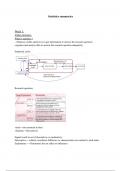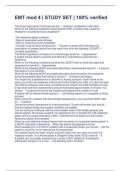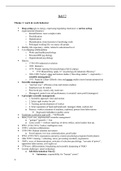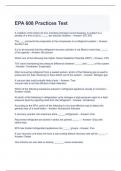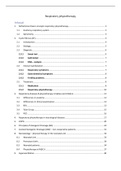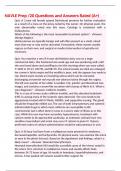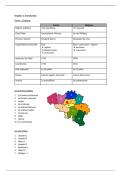Summary functional genomics
1
,Chapter 1 intro functional
genomics
2
,Chapter 2 Sequencing
The key of this chapter is to understand the principle of Sanger sequencing. Moreover, amplification-
based next generation sequencing (NGS) methods as well as non-amplification based ones are
assumed as familiar.
The need for NGS read complexity
One thing to point out though is that most fragments generated by NGS methods are aligned to the
reference genome to decipher the individual’s genetic code. In order to do this accurately, one must
have:
Sufficient coverage statistical strength and being sure of having sequenced each and every
position of the genome
Sufficiently large reads
Sufficiently complex reads repetitive sequences e.g. are not complex enough, such that
they occur too frequently in the genome to be 100% sure of their position
This can be explained according to the following calculation:
The complexity of reads ~ #positions x #optional bases at each position the more complex
the possible reads, the less frequent a read will occur on more than one place in the
(reference) genome
if you have a read length of 4 bases which can be ATGC, than there are 256 possible reads
therefore, two of the same such 4 base reads will on average occur each 256 nucleotides of
the genome (which is in a 3 million bp genome still very often!)
Different applications of NGS methods
Sequencing is core to many types of genomic analysis techniques. The most important of these
techniques and their general application are described in the box below:
WGS and targeted genome sequencing
WGS and targeted genome sequencing are used to detect mutations, although because of practical
reasons the latter is more frequently used in a diagnostic setting.
3
, RNA sequencing (RNA-seq)
The tissue-specific gene expression profile can be constructed by RNA sequencing. As might be
known, RNA is only transcribed in the case a gene is expressed. Therefore, by isolating the all RNA
from a specific tissue sample, one can reverse transcribed it into cDNA, that is on its turn amplified
by DNA pol.
mRNA is spliced so RNAseq only covers the exons when aligned to the
reference genome
Two types of primers:
3’ polyA complementary poly-T primers always present on
mRNAs but gives a bias for the 3’end as this end will in this
way yield many more reads
compared to the 5’end
Random hexamers: primers that
hybridise to random places in
the RNA no bias, but not all
hexamers are effective
Chromatin-immunoprecipitation sequencing (ChIP-seq)
ChIP-seq is a technique that is used to precisely locate the binding sites of specific proteins to the
chromatin. To do so, the technique
crosslinks all proteins to the DNA and fragments it
upon which only the crosslinks with the protein of interest is precipitated
out of the sample by the use of that protein of interest-specific
antibodies
crosslinks are then reversed and the associated DNA fragments are
sequenced after they have been ligated to known adapter sequences for
primer hybridisation
DNaseI/ATAC sequencing
DNaseI and ATAC sequencing are two techniques used to distinguish (relatively) accessible regions of
the genome from inaccessible ones, and thus to probe the chromatin packing density
heterochromatin from euchromatin distinguished.
ATAC sequencing: Tn5 transposase randomly inserts known transposon sequence with
adaptors for primer hybridisation sequenced regions aligned to reference genome were
accessible to transposase and therefore are euchromatic
DNaseI sequencing relies on the same accessibility premise as ATAC sequencing, only the
resultant sample differs in that accessible genomic regions have been digested in contrast to
4
1
,Chapter 1 intro functional
genomics
2
,Chapter 2 Sequencing
The key of this chapter is to understand the principle of Sanger sequencing. Moreover, amplification-
based next generation sequencing (NGS) methods as well as non-amplification based ones are
assumed as familiar.
The need for NGS read complexity
One thing to point out though is that most fragments generated by NGS methods are aligned to the
reference genome to decipher the individual’s genetic code. In order to do this accurately, one must
have:
Sufficient coverage statistical strength and being sure of having sequenced each and every
position of the genome
Sufficiently large reads
Sufficiently complex reads repetitive sequences e.g. are not complex enough, such that
they occur too frequently in the genome to be 100% sure of their position
This can be explained according to the following calculation:
The complexity of reads ~ #positions x #optional bases at each position the more complex
the possible reads, the less frequent a read will occur on more than one place in the
(reference) genome
if you have a read length of 4 bases which can be ATGC, than there are 256 possible reads
therefore, two of the same such 4 base reads will on average occur each 256 nucleotides of
the genome (which is in a 3 million bp genome still very often!)
Different applications of NGS methods
Sequencing is core to many types of genomic analysis techniques. The most important of these
techniques and their general application are described in the box below:
WGS and targeted genome sequencing
WGS and targeted genome sequencing are used to detect mutations, although because of practical
reasons the latter is more frequently used in a diagnostic setting.
3
, RNA sequencing (RNA-seq)
The tissue-specific gene expression profile can be constructed by RNA sequencing. As might be
known, RNA is only transcribed in the case a gene is expressed. Therefore, by isolating the all RNA
from a specific tissue sample, one can reverse transcribed it into cDNA, that is on its turn amplified
by DNA pol.
mRNA is spliced so RNAseq only covers the exons when aligned to the
reference genome
Two types of primers:
3’ polyA complementary poly-T primers always present on
mRNAs but gives a bias for the 3’end as this end will in this
way yield many more reads
compared to the 5’end
Random hexamers: primers that
hybridise to random places in
the RNA no bias, but not all
hexamers are effective
Chromatin-immunoprecipitation sequencing (ChIP-seq)
ChIP-seq is a technique that is used to precisely locate the binding sites of specific proteins to the
chromatin. To do so, the technique
crosslinks all proteins to the DNA and fragments it
upon which only the crosslinks with the protein of interest is precipitated
out of the sample by the use of that protein of interest-specific
antibodies
crosslinks are then reversed and the associated DNA fragments are
sequenced after they have been ligated to known adapter sequences for
primer hybridisation
DNaseI/ATAC sequencing
DNaseI and ATAC sequencing are two techniques used to distinguish (relatively) accessible regions of
the genome from inaccessible ones, and thus to probe the chromatin packing density
heterochromatin from euchromatin distinguished.
ATAC sequencing: Tn5 transposase randomly inserts known transposon sequence with
adaptors for primer hybridisation sequenced regions aligned to reference genome were
accessible to transposase and therefore are euchromatic
DNaseI sequencing relies on the same accessibility premise as ATAC sequencing, only the
resultant sample differs in that accessible genomic regions have been digested in contrast to
4

